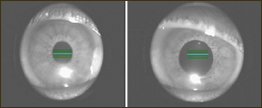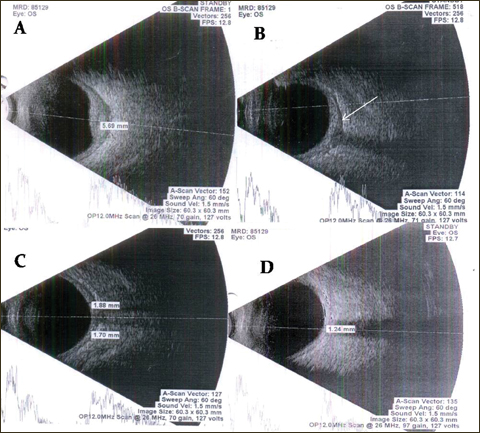Case report: Woman presents with posterior scleritis
Posterior scleritis continues to be the prominent differential diagnosis of subretinal and choroidal swellings. Therefore, it is imperative to know that it can present clinically as exudative retinal detachment, proptosis, disc edema, choroidal folds, subretinal mass, myositis and rarely glaucoma, periorbital edema, chemosis and conjunctival injection. It is mostly found in women older than 40 years of age. In this case report, we present the clinical diagnosis and management of an isolated case of posterior scleritis.
Patient and presentation
A 45-year-old healthy woman presented with pain, redness and photophobia in the left eye for 12 days’ duration. She had no relevant ocular history. Her best corrected visual acuity was 20/50 in both eyes. On slit lamp examination, there was mild anterior chamber reaction and a relative afferent pupillary defect (Figure 1) in the left eye while the right eye was normal. She had grade 2 nuclear sclerosis in the lens of both eyes. Color vision was minimally affected in the left eye and normal in the right eye. Fundus evaluation showed a large subretinal elevation underlying the optic disc area, causing optic disc edema (Figure 2) with flame-shaped hemorrhages and choroidal folds stopping short of the macula. Ultrasound B-scan showed a diffuse subretinal mass (Figure 3) with no pathognomonic “T sign.” MRI of the orbit with contrast revealed an irregular choroidal mass with inhomogeneous enhancement with no conclusive diagnosis. Routine investigations such as CBC, ESR, serum urea, creatinine, random blood sugar, liver function tests and chest X-ray were performed. All blood investigations were within normal limits, but Mantoux test was borderline. With choroidal melanoma as our provisional diagnosis, fundus fluorescein angiography did not show dual circulation. Interestingly, B-scan at 1 week after initial presentation showed choroidal thickening and fluid in the Tenon’s space as early T sign (Figure 3). Automated perimetry showed a temporal field defect in the affected eye.
The patient was started on methylprednisolone injection 500 mg with 300 mL normal saline pulse dose, followed by oral steroids. There was significant reduction in optic disc swelling, and the choroidal folds disappeared. On serial B-scans there was reduction in choroidal thickening and fluid collection. One month after stopping the steroids, the patient presented again with a decrease in vision and swelling inferonasal to the disc in the left eye. Specific investigations such as QuantiFERON-TB, ANA, p-ANCA and c-ANCA were performed, and QuantiFERON-TB turned out to be positive. She was started on an anti-tuberculous regimen, which included isoniazid, rifampicin, pyrazinamide and ethambutol. The swelling reduced clinically, and choroidal thickness measured normal on B-scan at 6 months (Figure 3). The patient’s BCVA after 6 months was 20/30, and she was asymptomatic.

Images: Agarwal A


Migratory scleritis mimics melanoma
Ten percent of all cases of scleritis are posterior in nature, and one-third of cases are associated with systemic diseases. Few of them have no detectable physical signs on the initial examination. In a large review of 400 patients referred to the ocular oncology service, nodular scleritis accounted for 1.5% of all lesions resembling choroidal melanoma. The initial funduscopic and radiological findings were suggestive of amelanotic melanoma. Failure to make the correct diagnosis could lead to misguided treatment. Appearance of T sign and response to systemic steroids aided in the diagnosis of inflammatory pathology. However, recurrence of the lesion after some time made us look for further reasons to rule out tuberculous origin. Yap and colleagues noted that scleritis can be an early or masquerading sign of choroidal melanoma. In their series of three cases, they noted all presented with prior scleritis that was confirmed by histopathology as melanoma on enucleation.
Scleritis in tuberculosis
Tuberculosis is known to cause about 3 million deaths every year worldwide. Because there are no uniform diagnostic criteria for intraocular tuberculosis for either immunocompetent or immunocompromised individuals, arriving at a diagnosis and management becomes cumbersome. Posterior scleritis is rarely known to present alone in tuberculosis, and hence there is not much literature on the topic. In our case, other systemic manifestations of TB were absent, and Mantoux test and chest X-ray were inconclusive. QuantiFERON-TB is an in vitro blood test based on interferon-gamma release assay with specific antigens for Mycobacterium tuberculosis, and these are helpful to screen for latent TB infection. If this investigation was missed in this case, the diagnosis of TB would probably have been missed and the patient would have had recurrences. Therefore, in a case of isolated posterior scleritis, one needs to not overlook TB as a differential diagnosis in the absence of other ocular manifestations and systemic features. In a refractory case, one can do polymerase chain reaction in blood or ocular fluids, and rarely histopathology may be required for confirmation.
Conclusion
Posterior scleritis can present as a mass in the choroid mimicking amelanotic melanoma with inconclusive signs on B-scan. Clinicians should be alert to the circumstances in which malignant melanomas of the choroid can masquerade as scleritis. One should not forget that the tuberculous etiology in developing countries can have varied presentations. Nevertheless, careful ophthalmoscopy, ultrasonography and sequential radiological imaging are crucial to reach the accurate diagnosis.
- References:
- Biswas J, et al. Ocul Immunol Inflamm. 2012;doi:10.3109/09273948.2011.628195.
- Chang KC, et al. Thorax. 2010;doi:10.1136/thx.2009.126771.
- Dye C, et al. JAMA. 1999;doi:10.1001/jama.282.7.677.
- Gupta A, et al. Indian J Ophthalmol. 2003;51(4):347-349.
- Gupta V, et al. Surv Ophthalmol. 2007;doi:10.1016/j.survophthal.2007.08.015.
- Liu AT, et al. Indian J Ophthalmol. 2015;doi:10.4103/0301-4738.176038.
- Mazurek GH, et al. Clin Infect Dis. 2007;doi:10.1086/521107.
- McCluskey PJ, et al. Ophthalmology. 1999;doi:10.1016/S0161-6420(99)90543-2.
- Sharma R, et al. Kathmandu Univ Med J. 2010;doi:10.3126/kumj.v8i3.6228.
- Shields JA, et al. Ophthalmology. 1980;doi:10.1016/S0161-6420(80)35201-9.
- Yap EY, et al. Ophthalmology. 1992;doi:10.1016/S0161-6420(92)31744-0.
- For more information:
- Amar Agarwal, MS, FRCS, FRCOphth, is director of Dr. Agarwal’s Eye Hospital and Eye Research Centre. Agarwal is the author of several books published by SLACK Incorporated, publisher of Ocular Surgery News, including Phaco Nightmares: Conquering Cataract Catastrophes, Bimanual Phaco: Mastering the Phakonit/MICS Technique, Dry Eye: A Practical Guide to Ocular Surface Disorders and Stem Cell Surgery and Presbyopia: A Surgical Textbook. He can be reached at 19 Cathedral Road, Chennai 600 086, India; email: dragarwal@vsnl.com; website: www.dragarwal.com.
Disclosures: Agarwal reports he is a consultant for STAAR Surgical. Kumar and Chandran report no relevant financial disclosures.
